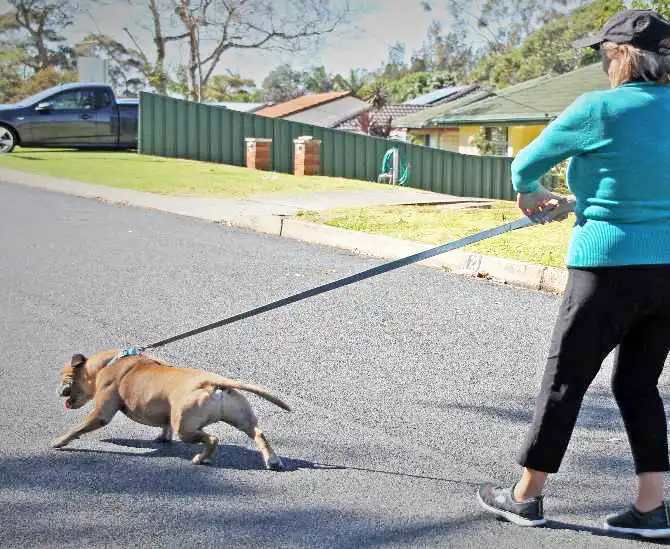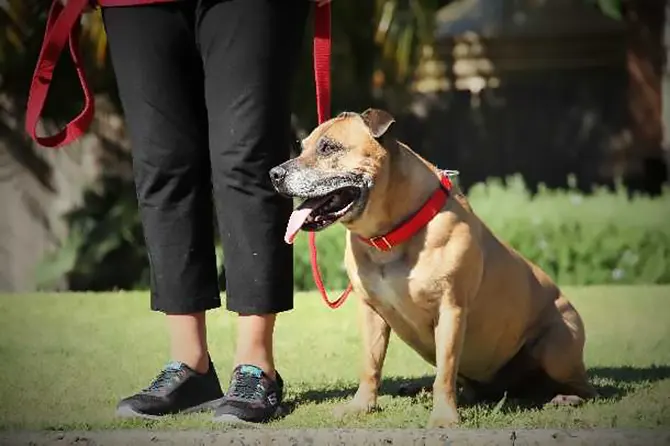The Staffordshire Bull Terrier is rated high on Bark Busters trainers list of popular breeds, coming in as the 3rd in Australia, New Zealand, United Kingdom and Canada, and the 4th most popular trained breed in the USA.
Staffordshire Bull Terrier Training
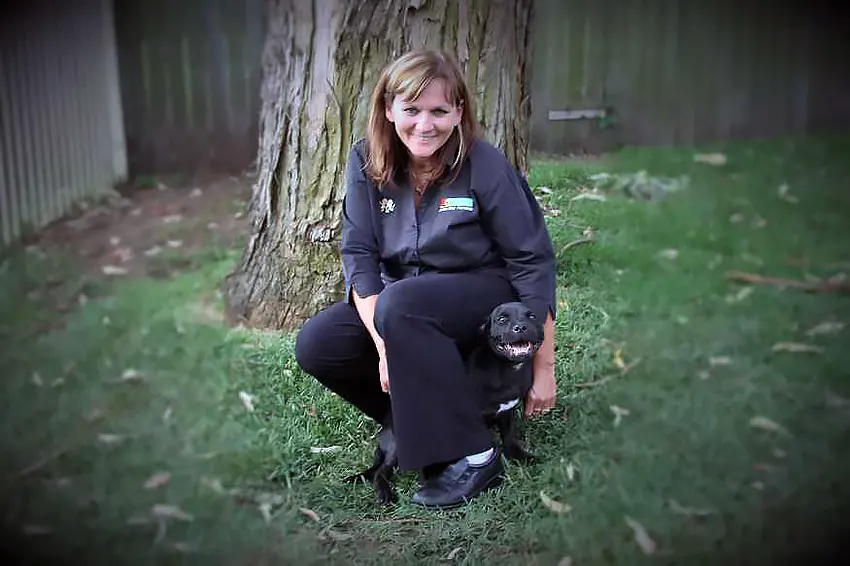
We have mentioned the common behaviour problems and traits of the Staffordshire Bull Terrier that are easily addressed with consistent education and training. They are not the type of breed that wants to constantly test you.
Here are some of Bark Busters' International Head of Training, Donna Ryan's training tips:
Grabbing the Lead
This is an issue that does occur regularly with this breed and generally stems from either frustration on the dog's part or a learned behaviour from when it was a puppy and was first introduced to the lead.
Most Staffys stop this annoying behaviour if it is addressed properly and at the precise time that your dog is grabbing the lead.
Be sure you don’t turn the exercise into a battle of wills, or the dog will win. You must be in control and show your dog know that this behaviour is not acceptable.
Never hit or try to grab your dog or drag the lead out of your dog's mouth. Neither of these actions will build trust. Be patient and in control.
Dog Aggression
Due to its breed history, the Staffy is not one to walk away from a fight. It is not usually the first one to start a fight but has been known to finish the odd one or two.
Most of the dog aggression cases that Bark Busters encounters stem from a 'bad experience' that the dog has had as a puppy or adolescent.
Dog aggression is very serious and needs professional help to resolve the problem. If you find yourself in over your head, seek professional help. In the meantime, if you are in any doubt start to muzzle train your dog to protect your dog and others too. There is no shame to place a muzzle on your dog, until you have the problem under control. The United Kingdon has hefty fines, and even custodial sentences, for dog owners whose dog is dangerously out of control. It is always better to be safe than sorry.
Recall - Coming when called
The Staffy is generally not deliberately disobedient. We usually find that its inability to return to you when called stems from a lack of proper communication. Practice calling your dog on a long lead first, in a controlled environment or fenced area, then let the lead trail on the ground and call your dog to you in a pleasant and encouraging way. Your dog needs to understand your intentions and what you want from them, or they will just bound away to investigate more interesting things.
Over-Exuberance
Over-zealous and excitable behaviour is common with most Staffordshire Bull Terriers. If you want to quell this over-exuberant behaviour, practice some calm interaction with your dog. Don’t turn on your 'excitement meter' when you arrive home but enter the home and interact in a calm way. The worst thing you can do with an excitable breed is to act in an excitable way. They will just match your behaviour and ramp it up.
History
Staffordshire Bull Terriers are energetic, fun loving, and in great demand as the all-round family dog. The Staffy, as they are affectionately referred to, are a very loving breed that want nothing more than to settle down for a cuddle with you after a fun-filled day. It is their sweet nature, their ability to romp and play and then cuddle and chill out, that keeps them near the top of the 'most popular breeds list' around the world. This breed is generally over-exuberant in their display of affection, and all Staffy's possess that trait of squirmy, jumping, and licking as they greet their owners when they arrive home. This is what most Staffy parents love about the breed, but it can be a turn off for those who can't cope with the 'rough and tumble' behaviour. With patience, education, and training, they can be just as well behaved as any breed. They are definitely worth the effort.
The breed has a defined muscular appearance that can look intimidating, but their natural love of people shines through and wins everyone's heart in no time.
The Staffy, is classed as a medium sized dog with a similar appearance to the much larger, more powerful American Staffordshire Terrier and American Pit Bull Terrier.
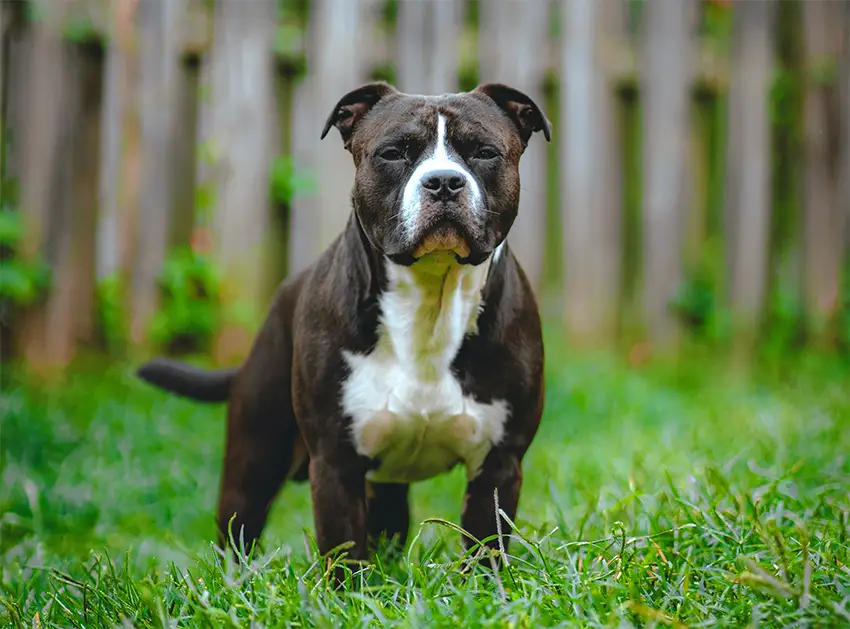
The Staffordshire Bull Terrier originated in England and is a tenacious and courageous short coat breed. It was one of the breeds used for bull and bear baiting before the 19th century when sports such as cockfighting were commonplace, and animal rights not yet fully in place.
As far back as the 16th Century, there was a common practice at the cattle markets to set dogs on the bulls and cattle as a way of tenderising the meat and providing entertainment for the spectators. Fights with bears and other animals were also organised as entertainment.
The early bull dogs and terrier types were remarkably different from the breeds of today and were selected mainly for their gameness, inbred courage, and aggressiveness.
Terriers and other popular dogs of the time, bred with bulldogs, provided the ancestral foundation stock for the Staffordshire Bull Terrier.
Eventually the practice of these blood sports was phased out or eliminated in 1835 as animal rights organisations like the RSPCA came into being.
However, the practice of dog fighting continued, where folks could test the fighting strength and courage of their dogs in secret locations. The barbaric dog fights were supposedly a form of entertainment and involved gambling. They usually took place in a pit and the last dog standing, or alive, was declared the winner.
Despite its violent history, the modern-day Staffordshire Bull Terrier is a breed that has the ideal temperament to be a family dog and trustworthy companion.
Personality and Temperament
Anyone who has a Staffordshire Bull Terrier will tell you that they adore this breed. They are lovable and adaptable. They are a great family dog that loves to join in any activity. Don’t let their looks fool you. Although they look tough on the outside, they are sensitive, loving and very low maintenance. These dogs are very trainable and Bark Busters training methods suit their intelligent personality.
Management
Don’t leave your Staffordshire Bull Terrier puppy confined for long hours because they don’t do "Home Alone" too well, and they can become frustrated and behaviour problems could surface. These dogs love company and need to be kept active.
Create a place in your home that contains everything your Staffy will need for those times when you need to leave them alone. This can be found in our "four basic needs" listed below.
Don’t forget the most important element of all is 'you' and your positive influence that will make all the difference.
You should be the 'decision maker' in the relationship and influence the good choices that your dog makes by giving lots of praise when it does what you want it to do.
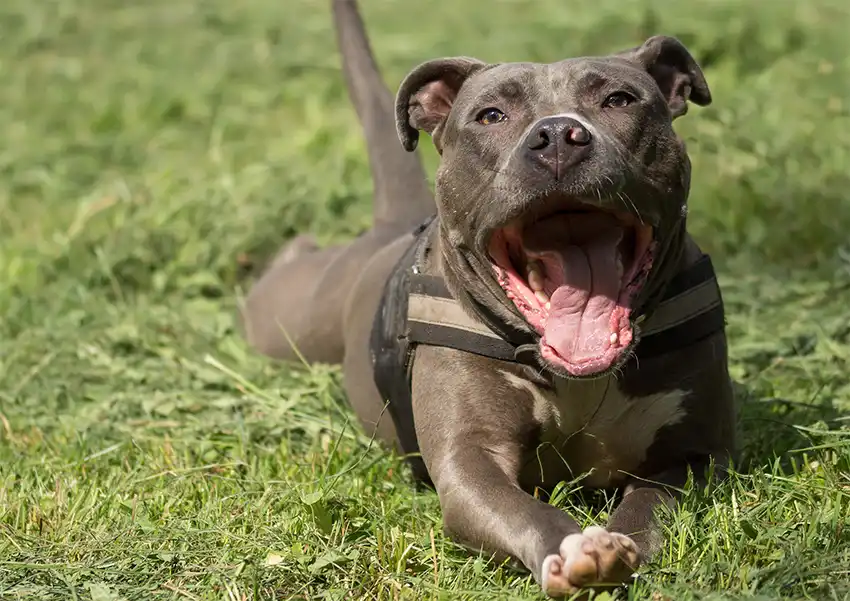
The Right Training for Your Staffordshire Bull Terrier
Staffy's are keen to please their humans and will play the clown or the serious role with ease. Most behaviour problems, especially in relation to 'dog aggression', stems from standing their ground and their unwillingness to walk away from a fight, that they generally didn't start, and the inability of their owner to control this behaviour.
The most prevalent behaviours we are called upon to deal with are dog aggression, biting the lead during the walk, excitable behaviour, and a small amount of human aggression, which usually stems from poor breeding or lack of training and handling.
More often than not, their pet parents do seek out professional training to deal with their over-exuberance.
Savvy dog fanciers understand the importance of locating the right training for their dog which is kind and humane, dog friendly, and taught by experts who have the skills to deal with the breed. People who lead hectic lives, find that Bark Busters Home Training suits their lifestyle.
Why home training? Well, this is where most problems occur, this is also where dogs feel safe, are less stressed and have fewer distractions. The modern-day dog parent is looking for fast results without having to use any harsh methods.
Capabilities of the Breed
The Staffordshire Bull Terrier is a tough breed of dog, full of confidence and self-reliance. Fun to have around and definitely capable of being a lap dog. They would love nothing more than to be with you wherever you are.
They are possibly not the world’s greatest guard dogs because of their love of people, but their looks can be a deterrent.
Although they are good with kids, always monitor their behaviour and never leave dogs and children unattended.
For those outdoor enthusiasts, they are a great hiking companion.
The Staffy is good with other animals and dogs if introduced properly.
A very trainable and cooperative breed of dog.
Staffordshire Bull Terrier Tips and Case Studies
The Staffordshire Bull Terrier is a very adaptable and trainable dog. They just want to please and are always full of energy. However, you do need to have patience when training, or their fun-loving personality can wear you out. They always seem to be ready for the next big thing and keeping their full attention is always challenging.
The over-exuberance in the Staffy, jumping, nipping, and barking, is one of their best and worst traits. They need their owners and people they meet, to always keep calm and ignore them until they are calm. They are a very soft natured dog, so they go from manic to submissive in a second.
The Staffy tends to be over-zealous with other dogs. A lot of their excitable behaviour with other dogs ends up with them humping the other dog, and because they are so strong, this can cause problems with other dogs. The other dog will try and get away, but the Staffy holds tight, and this invariably leads to a fight.
The Staffy likes to play fetching games, so spend some time teaching them to bring their ball back, or hiding their ball and sending them to find it.
We find that by keeping the exercises short and fun, they stay focused on what we are trying to teach them.
Treats can be great motivators for training Staffordshire Bull Terriers, but if your dog will only obey for a treat and you need to have treats always on hand to get the best out of your dog, then the dog is in charge of things, not you and this is not conducive to controlling a lively, energetic breed.
We find that 'communication' built from consistent education, is the key because we always have our voices with us and as long as you keep the sessions short, you will get great results from this breed.
Health
Everyday Illnesses and Injuries
Your Staffordshire Bull Terrier’s health concerns will change over the course of their life. A puppy might be more prone to eat something they shouldn’t, a 2-year-old Staffy may be more likely to develop allergies, and a senior Staffy is far more likely to develop arthritis as they age. Staffordshire Bull Terriers also have personality and physical traits that may make them more prone to certain conditions—an active Staffy that loves to run around the yard may be more prone to rupturing their knee ligament.
If you are ever concerned about your dog’s health, your local veterinarian is a great resource.
Like many popular breeds, the Staffordshire Bull Terrier has its fair share of hereditary based issues, such as hip and elbow dysplasia. Most reputable breeders now have their breeding stock checked and scored by a vet for these hereditary ailments. You can request proof that the puppy you are purchasing comes from parents that have been checked for these issues.
Many other health issues are also hereditary, so we recommend you do some research on the ancestry of your puppy and any health issues of that particular breed.
Preparing Yourself
As a pet owner, you should expect to pay for basic veterinary care like vaccines, spay/neuter, and annual checkups. Many pet owners don’t consider the unexpected illnesses and injuries that can occur throughout a pet’s life and fail to prepare for them. Medical insurance can help a pet owner prepare and lessen unexpected bill in later life. As with most insurance you pay a monthly premium to be covered for eligible veterinary expenses. Every provider is different, offering varied coverage with different plans, pricing options and limitations. As you do your research, pay close attention to coverage, deductible options, ease of use, and if pre-existing conditions are covered.
Toilet Training
There are definite times when your puppy will need to toilet. Here we identify six critical times.
- Immediately after eating or drinking
- When they first wake up in the morning
- After exuberant play
- When woken during the night, such as the phone rings or you get up to use the bathroom.
- When you arrive home and your dog greets you
- If they get frightened or scared by something or someone
Take your puppy to a designated toilet area. Grass or dirt is best as we don’t want them associating their toilet with anything related to carpet or floors in general.
Toilet Training Aids
If you need to leave your puppy or dog for any length of time, it might be wise to provide an indoor toilet that you can eventually transition to the outdoors. Artificial grass products can be good and one that we would recommend if you can setup an indoor toileting area.
Puppy Selection
If selecting your Staffordshire Bull Terrier puppy from a breeder, ensure you view both parents to determine the type of personality your puppy might grow up to have.
Don’t concern yourself too much if one of the parents is the type of dog that barks on your approach to the property, providing they are friendly once you have gained access.
Check out the hereditary history of the parents. Check whether any of the parents or grandparents had any genetic diseases. Check our health checks in this section.
Puppies inherit a lot from their parents and ancestors, including their personality, their genetics, and their characteristics and personality. If you spot a parent that has some signs of serious aggression or fear issues, this dog is more likely to produce offspring that will inherit some or all those traits.
Puppies also learn a lot from their parents in their environment, especially when they are with their mother. She guides their behaviour in the early weeks. If she is tolerant and outgoing, then the puppies will usually be the same. If they encounter kind and gentle humans, then they will be accustomed to humans and will feel good about them.
The right type of early puppy education from its mother and siblings is an important factor towards how well-adjusted your puppy will be and how it will behave in the future. For this reason, it is not wise to take possession of your puppy until at least 8 weeks of age, but 12 weeks is preferable. Experienced breeders will want to adhere to this as they know that the puppy gains a lot of education if it is allowed to stay in that environment a little longer.
Be wary of anyone who says that you can take your Staffy puppy away at the age of 4 to 5 weeks or you cannot see the parents. Your puppy is missing out on vital education from its mother, which will affect its behaviour in the future.

Select the puppy that suits your personality and lifestyle
When selecting a Staffordshire Bull Terrier puppy, be sure to select the personality of puppy that suits your lifestyle.
You will need to give thought to the amount of time you have to devote to your puppy. Ensure that that you have the room needed to accommodate a lively breed and that you are confident in educating such an energetic breed of dog.
Think carefully about the amount of time that your new dog or puppy will have to spend alone. The Staffy is not great on being left alone for long periods of time. You might need to budget for a dog walker or consider a doggy daycare.
Should We Adopt One Puppy or Two?
Bark Busters offer lots of advice to new dog and puppy parents and we have a huge resource of information on the needs of dogs, how to best manage them, and what works.
New dog parents often ask us whether they should adopt one or two Staffordshire Bull Terrier puppies. Our answer is always the same. Only adopt two if you actually want two puppies.
Their concern is that their dog will be lonely when left alone and they are out at work of rover 8 hours. We have all seen the animated film 'The Secret Life of Pets’ and what dogs get up to when left alone. Although fiction, many of the things they depicted in that movie were based on fact.
Dogs do suffer separation anxiety and resort to, destructive behaviours such as chewing furniture, counter surfing and raiding the bin when left to their own devices. Not to mention 8 hours is a long time when you need to go to the toilet.
In that movie, one of the pet parents brought home another dog for her "Home Alone" dog and initially they did not hit it off. This again is based on fact because truthfully some dogs don’t. Even dogs from the same litter can suffer from sibling rivalry.
All puppies are adaptable if given the right environment and education in which to thrive. They soon look upon you as part of their pack, a two-legged dog, and they can fit right into that social structure with ease.
Some folks find it hard to fathom that a dog might look at them as they would another dog. However, many people will think of their dog as a little four-legged human!
A puppy and a kitten are a good option if you are not looking to add another addition to your family unit. However, if you are introducing a kitten to an older dog, this needs to be done with great care. If the puppy and kitten join your family from day one, then it shouldn't be too much of a problem.

Some Things to Look for During a Dog or Puppy Selection
Most dogs will be good watchdogs in the appropriate circumstances, so be selective and avoid the obvious pit falls when selecting the dog with who you wish to share your life. However, we never recommend getting a dog as a watchdog because you really cannot expect your dog to bark at people at home and then not bark at people when out and about.
Although the Staffy is generally a friendly, fun-loving breed, occasionally you will encounter that undesirable personality. So be selective and make sure you follow the Bark Busters’ check list on what to look for when selecting your new Staffordshire Bull Terrier dog or puppy.
When searching for a Staffy be sure to check out your local animal shelter or rescue, even if you are looking for a puppy. Many of these dogs were surrendered just because of their over-exuberance and many had litters in the rescue.
Bringing a New Puppy Home
Always try to bring your new dog or puppy home early in the day. The reason behind this is that they will need time to become accustomed to their new home.
If you can bring something from their old home, like some bedding or a toy, this will help them to settle.
Ensure that you have pre-selected a designated area for your new dog or puppy, a place where they will rest and sleep, and then start to get them used to their new area. You can do this by feeding them in the new area during the day and spending time with them there. If you have selected a crate, place your dog in it well before bedtime, so you have time to see how they are going to react when you leave. Be sure to select a place for your dog to sleep that is practical. It should not be your bed unless you are determined to always have your dog sleep with you. Otherwise, you won’t break that habit easily.
If your dog or puppy begins barking or crying, don't rush back. That will only make the situation worse. Instead stay close by and address their concerns. This will calm them faster than rushing back each time they bark or cry out. If you rush back every time they cry or bark, they will soon believe that all they need to do is cry out and you will appear. Remember they did have a home before this one and they will need time to learn to adapt to their new home.
Puppy Training
Any training of a puppy must be gentle and dog friendly. Puppies need special care because they are experiencing everything for the first time. They are very impressionable in the first year and need patience and understanding to set their education on the right path.
Bark Busters trainers are very experienced at dealing with all puppy issues. Our puppy training takes a positive approach and it's not a 'one size fits all'.
Our trainers assess the personality of the puppy and tailor the training to suit the puppy's personality and the owner's needs.
We assess the way your puppy is behaving and advise you how to manage common puppy issues, such as toileting and destruction.
Puppies need to be managed, have structure in their life, education, entertainment, and the right nutritional diet. They also need regular vet checks to keep them healthy and happy.
Puppy Socialisation
The best type of safe socialisation for your Staffy puppy is with dog owners you know have a friendly dog. One that is sensible and not intimidating towards puppies. The Staffy nearly always meets everything head on, which can be disconcerting for the more sedate personalities in the dog world. Some dogs won’t tolerate a lively puppy that jumps all over them, and they may try to put the insubordinate puppy in its place.
This interaction quickly solves the problem but leaves an ever-lasting impression; one that can manifest into dog aggression.
Avoid taking your puppy to a dog park or local park where there will be lots of dogs. Instead start by introducing your puppy to only one or two dogs in a controlled manner. Be sure to control your puppy’s over-exuberance too or fights and scuffles could breakout.
The Wrong Kind of Socialisation
Many new puppy parents cannot wait to take their new puppy out in public or straight to the park to meet lots of other dogs. This is where some of the seeds of misbehaviours are sown. Bark Busters get to see the results of how these hasty decisions can cause fear and dog aggression problems.
Some older dogs or puppies can be intimidating which is possibly going to frighten an inexperienced puppy and possibly cause it long-term behaviour problems, which can turn to late onset aggression towards other dogs. Be selective of which dog you choose to play and socialise with for your puppy.

Taking Your Staffordshire Bull Terrier Puppy to Dog Parks
If you are determined to take your dog to a doggy park, we recommend that you wait until they have reached 12-months of age. The concern about dog parks is the natural intimidation that older dogs can display when they encounter puppies. This can give your puppy a lasting bad impression, which can later lead to dog aggression as your puppy reaches maturity.
The Staffy is not the type of breed to take a backward step if another dog provokes them. This could cause you long term problems and mean that your dog never gets to go back to the park for fear of fights with other dogs. So be patient and let your dog mature first and allow it to develop a trust that does not have to worry about other dogs when it goes out. Let your puppy enjoy pleasant experiences with well-behaved dogs or puppies.
If fully immunised, you can sit with your puppy on your lap in a public area or park, where it can watch the world from a safe place. This way it won’t be intimidated or frightened by over-exuberant mature dogs or other puppies.
Four Basic Needs
Your dog has four basic needs in life to keep it happy healthy and content.
Let's examine those four basic needs and why your dog needs them to keep it healthy, balanced and content.
Food - diet / nutrition
We promote a diet that is grain free, low in carbohydrates and without any harmful e-numbers, colours and preservatives. Carbohydrates do add energy that the dog needs to burn off and can make an already hyperactive dog more active.
The right diet, grain free and filled with fruits, vegetables and raw meat will have advantages to how your dog will feel, look and act.
If you want to understand why grains can make a dog more energetic, you only need to think of racehorses and how their trainers give them grain to get highly energetic racehorses. Energy in, equals energy out.
Bark Busters dog trainers are not vets or dietitians, so we urge you to do your own research into the best diet for your dog. A diet that you will be comfortable with.
We do however have vast experience at how highly concentrated grain diets effect behaviour and can cause hyperactivity. This is very prominent in Japan, where most dogs are fed high levels of rice in their diet which can adversely affect concentration and focus.
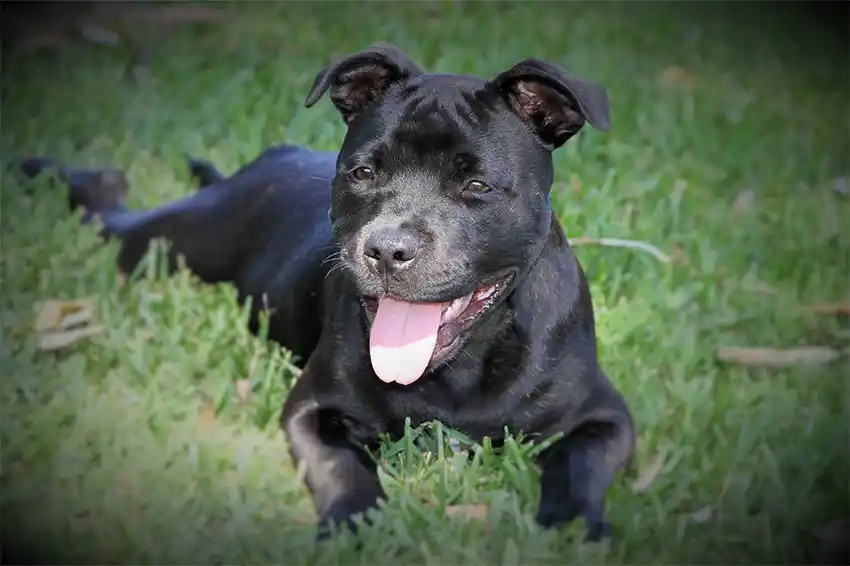
Safety - through leadership and education
All dogs need strong leadership and to know where they fit into the family unit. If they know they have a leader that will make all the decisions, one who is fair and just, they will be happy and content.
On the other hand, if they have no structure in their life, they have inconsistency, and don’t know how things will be from one day to the next, then they will become stressed and may experience health ailments, skin and stomach issues and behaviour problems. Routine and respect must be established. With equal doses of love and structure your will feel safe and secure.
Shelter - a place to call their own
Dogs love nothing better than to curl up on the couch or in a place they can call their own, even when there is more than one dog. Most dogs are very sociable, and they will think nothing of all snuggling in together. Provide your dog with its own "den", a place where they can call home, and somewhere they can go to for a bit of peace and quiet. Just make sure their "den" is warm, easy to clean and maintain.
Entertainment - toys and games
A very important part of your dog's four basic needs is their need to have something to do. If we want to avoid our pets becoming bored and destructive, then they need a way to fill their day.
Dogs thrive with physical and mental exercise. Dogs are highly intelligent animals, and they need to keep their brains active as much as their bodies. Entertainment is an important part of their well-being and essential to your dog's overall mental health.
One great toy is the Bark Busters GameChanger® which helps to prevent boredom, stress, and separation anxiety. By filling it with small treats, your dog will have plenty of fun trying to get the treats to dispense.
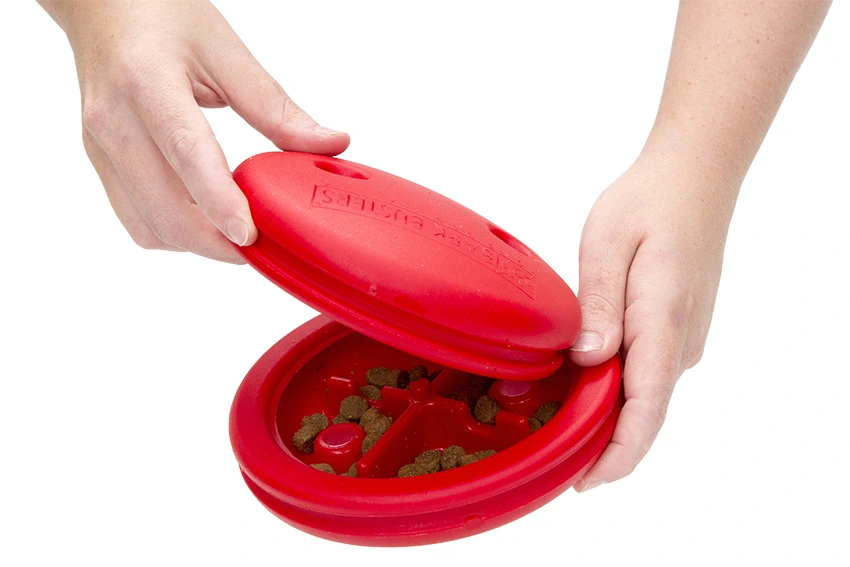
Games to Play
Try to play games that will enhance your dog’s behaviour, not increase its unwanted behaviour.
We recommend that you don't play wrestling, hand games or chasing games that encourage a dog to bite or run away. By playing these types of games you are teaching your dog bad habits, not good ones. These games encourage biting and running away, causing recall issues.
Tug of war games are fine as long as you control the game.
Child’s Play
Due to their size and energy levels, you must give thought to how your dog and children will interact. Any play between dog and children must be monitored and controlled at all times. Children have a way of getting dogs excited and this can lead to the dog inadvertently hurting the child through their natural excitable, boisterous behaviour.
Make sure that you educate the children to play sensibly and instruct them to play games that are less likely to lead to over-exuberance, such as hide and seek games or fetch games, not the rough and tumble type of games.
Wrestling with a dog will cause over-excitement and to play-bite every time it sees the children, eventually causing your children to try to avoid the dog, because they fear getting hurt.
Adult Play
Any form of play by the adults in the house should be measured and not aimed at over-exciting your dog. The Staffy can hurt you just with their play. They tend to never do things at half-measures. When you do play, play games like fetch the ball and tug-of-war games and make sure the game ends with you taking control of the item. Once the game is over, take the item out of play, with a 'Finish' command and lots of praise.
In controlling the game and the item we show our dogs, in a subtle way, that you are the decision maker and that you control the game.
It is best not to play rough and tumble or play games where you thrust your hands into your dog’s mouth. These types of games only teach dogs to bite your hand. This can lead to a situation where your dog will bite your hand anytime it comes close to you.
Bark Busters Lifetime Support Guarantee
Bark Busters dog behaviour therapists and trainers have trained more than 1 Million dogs worldwide and are renowned authorities in addressing dog behaviour with all-natural, dog-friendly methods. The Bark Busters training is the only service of its kind to provide International dog training guaranteed lifetime support. With hundreds of trainers around the world, Bark Busters continues its mission to enhance the human/canine relationship and to reduce the possibility of maltreatment, abandonment and euthanasia. Contact your local Bark Busters dog trainer to see how they can help.
This article is the copyright of Bark Busters® and is intended for information purposes only. Dog owners should fully research any problems that they may have with their dogs.

